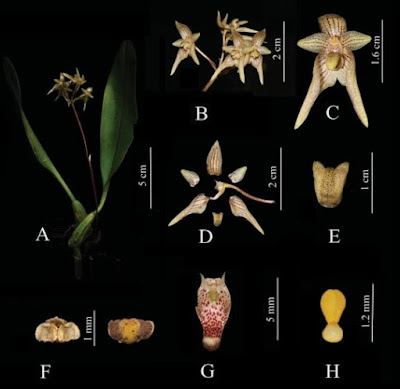 |
| Bulbophyllum putaoensis Q. Liu |
The orchid flora of Myanmar is highly diverse but as yet poorly known in the continental Asia, which is largely a result of periods of past instability and political isolation of the country. Also the remoteness of many orchid-rich areas and the difficulties of investigation in rugged terrain have also played a role (Ormerod & Kumar, 2003; Kurzweil & Lwin, 2014). According to recent estimates about 800 orchid species are distributed in Myanmar (Kurzweil & Lwin, 2014), which were probably underestimated. Many new distribution records and new species have been published in the last few years (Ormerod, 2002, 2006, 2012; Ormerod & Kumar, 2003, 2008; Ormerod & Wood, 2010; Nyunt, 2006; Kurzweil et al., 2010; Kurzweil & Lwin, 2012a,b; Tanaka et al. 2011).
.....
 |
| FIGURE 1. Bulbophyllum putaoensis. A. Habit. B. Inflorescence. C. Front view of flower. D. Dissected flower. E. Lip. F. anther cap G. Front view of column. H. Pollinarium. |
Bulbophyllum putaoensis Q. Liu, sp. nov.
Type: Myanmar. Kachin State. Putao County: Wasadam village, Epiphytic on the trunk of mountain rain forest, 830 m, 3 May, 2016, Q. Liu 330 (holotype, HITBC!).
Diagnosis: Bulbophyllum putaoensis is similar to B. umbellatum Lindley and B. chyrmangensis, but can be distinguished from them by having obliquely triangular column stelids; oblong anther cap and significant viscidium of pollinarium.
Distribution and Habitat: This new species was only found in the Kachin State, Myanmar. Epiphytic on the tree in tropical mountain rain forest, which associates tree species including Altingia excels (Altingiaceae), Knema linifolia (Myristicaceae), Elaeocarpus varunua (Elaeocarpaceae), Goniothalamus sp (Annonaceae), Beilschmiedia sp (Lauraceae).
Etymology: The specific epithet refers to the type locality, Putao.
Qiang Liu, Shi-Shun Zhou, Ren Li, Ming-Xia Zhang, Myint Zyaw, Shwe Lone and Rui-Chang Quan. 2017. Bulbophyllum putaoensis (Orchidaceae: Epidendroideae; Malaxideae), A New Species from Kachin State, Myanmar. Phytotaxa. 305(1);57–60. DOI: 10.11646/phytotaxa.305.1.9

